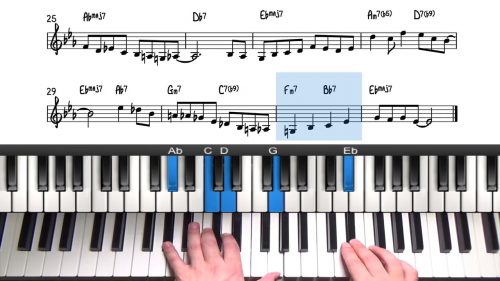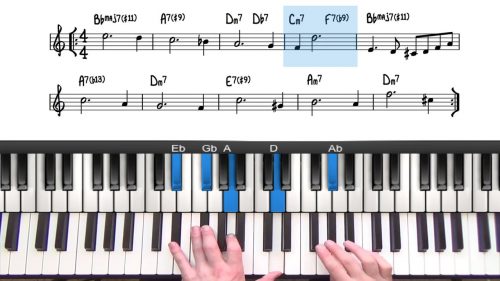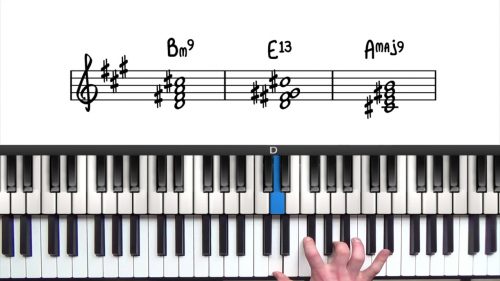There Will Never Be Another You Tutorial
‘There Will Never Be Another You’ is written in the key of Eb Major and follows a standard A-B1-A -B2 form.
The melody of the tune is very memorable as it contains a sequence of two virtually identical phrases, but the second one is played a major third higher diatonically. So basically that means that the intervals are the same, you just move the melody line up a major third in the key of Eb Major.
The tune contains a lot of step wise motion melodically which lends itself well to block chord harmonisation. Check out the introduction lesson on block chords before watching this lesson as that will give you some insight into the construction of these types of voicings.
We’re going start off by playing through the tune very freely in a rubato manner and then the second time through we will firmly establish the rhythm and timing and harmonise the main melodic phrases with block chords.
Practice Tips
-
If you're looking for a tune to practice the 4 way close and drop 2 harmony, this is it!
-
The melody moves in steps throughout making it a perfect candidate for block chord harmonisation.
- Check out the transcription exercise lesson on this tune where we analyse an improvised solo over the chord changes.





This is a lovely song to jam to. So much fun to play.
Thanks Adam, I’m glad you enjoyed the lesson. It’s also one of my favourite tunes.
You might like to check out this course where we study the tune in more detail: https://www.pianogroove.com/jazz-piano-lessons/how-to-play-jazz-band-jam-musicians/
Cheers! Hayden
You might also like this lesson where we apply the Red Garland voicing to this same tune: https://www.pianogroove.com/jazz-piano-lessons/red-garland-voicing-block-chord-tutorial/
That’s great fun to play around with.
Enjoy! Hayden
So very glad I got to click on this lesson – powered me up instantly! LOVE the melody big time! Your rubato style of playing it is just PERFECT! So tastefully performed like you would always do! There probably is already a discussion on this Jazz song – in the forum and would really like to check it out (in case :D) Thanks so much for this LOVELY lesson!!!!! Last question though – so do we have like a vocal score for this? No worries if none 😀 Thanks again!
Hi Haden, very helpful lesson. I don’t get, why there’s a flat 9 in the V chord in bar 32 (and in the turnaround afterwards), because it leads directly to the I chord (Bb7 to Ebmaj) Could you explain that to me?
Thanks a lot and keep up the good work!
Hi Swen, I’m glad you enjoyed the lesson!
The b9 can be added to any dominant chord to add a little more colour and tension. Sometimes it will work better than others so often it’s a process of trial and error.
In both example that you mention, we have the 13 (G) in the melody over the Bb7 chord, in which case the b9 works well underneath. The voicing I play both times is a Bb13b9 chord, which we can use visualise as a Bb7 shell in the left hand, and a G triad in our right hand in its 2nd inversion. The G triad gives us the tones 13-3-b9 which is one of my favourite Upper Structure Voicings.
Having the b9 in the V7 chord creates extra tension that strengthens the resolution back to the 1 chord.
It’s worth noting alterations are an optional addition, and so you don’t have to play them. Extensions and alterations are optional tones and so always follow your ear on what sounds best to you.
For more information on chord alterations, you might like to check out our chord alterations course: https://www.pianogroove.com/jazz-piano-lessons/altered-harmony-upper-structure-triads/
Also the whole step drills are useful for learning specific alterations in all 12 keys, for example this lesson where we take the b9 around all 12 keys using a whole step pattern: https://www.pianogroove.com/jazz-piano-lessons/13b9-chord-progression-drill/
I hope that helps Swen – and let me know if you have any further questions :–)
Cheers, Hayden
That helped me a lot. Thank you!!!
My pleasure Swen.
You might also like to check out my short “5 Minute Masterclass” studies: https://www.pianogroove.com/jazz-piano-lessons/5-minute-masterclass/
In particular the lessons on “Upper Structure Triads” and “Hearing & Resolving Altered Tensions”:
https://www.pianogroove.com/jazz-piano-lessons/what-are-upper-structure-triads/
https://www.pianogroove.com/jazz-piano-lessons/hearing-resolving-altered-tensions/
Those lessons should help with your understanding of chord alterations over dominant chords, and how this creates tension and a stronger resolution to the I chord.
Talk soon, Hayden